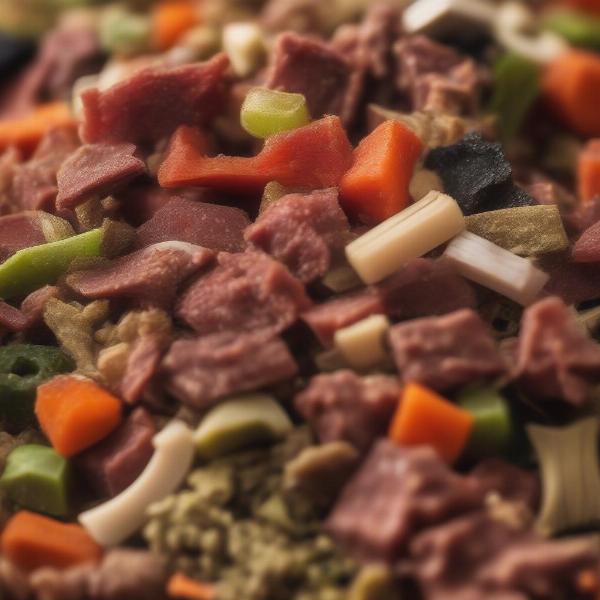Dehydrated raw dog food offers a convenient and shelf-stable alternative to traditional raw feeding, providing many of the same benefits without the mess and hassle of freezing. This guide delves into the world of dehydrated raw dog food, exploring its nutritional value, potential benefits, and things to consider before making the switch.
Understanding Dehydrated Raw Dog Food
Dehydrated raw dog food is made by gently removing the moisture from raw ingredients, typically meat, organs, bones, and sometimes fruits and vegetables. This process preserves the nutrients while extending shelf life. Unlike kibble, which is cooked at high temperatures, dehydration retains the enzymes and other sensitive nutrients often lost during cooking. This makes it a popular choice for dog owners seeking a raw diet option without the freezer space requirements.
What are the key benefits of feeding your dog dehydrated raw food? Many proponents believe it promotes healthier skin and coat, increased energy levels, and improved digestion. It can also be a good option for picky eaters, thanks to the intense flavor of the concentrated ingredients.
 Dehydrated Raw Dog Food Ingredients
Dehydrated Raw Dog Food Ingredients
Nutritional Value of Dehydrated Raw
Dehydrated raw dog food aims to mimic a dog’s natural diet in the wild. This means a high protein content from muscle meat, essential fatty acids, naturally occurring vitamins and minerals from organ meat and bone, and often a small amount of fruits and vegetables for added antioxidants and fiber.
However, not all dehydrated raw foods are created equal. It’s crucial to choose a brand that uses high-quality, human-grade ingredients and follows safe handling practices to minimize the risk of bacterial contamination. Look for a complete and balanced formula that meets AAFCO (Association of American Feed Control Officials) standards.
Transitioning to Dehydrated Raw
Switching your dog to a new diet should always be done gradually to avoid digestive upset. Start by mixing a small amount of dehydrated raw food with your dog’s current food, gradually increasing the proportion of raw over several days or weeks. Ensure your dog has access to fresh, clean water at all times, as dehydrated food requires rehydration before consumption.
Addressing Potential Concerns
Some common concerns surrounding raw feeding, including dehydrated raw, involve the risk of bacterial contamination and nutritional imbalances. While these are valid concerns, they can be mitigated by choosing reputable brands that prioritize safety and adhere to strict quality control measures. Consulting with a veterinarian is always recommended before making any significant dietary changes, especially if your dog has any underlying health conditions.
Is dehydrated raw food suitable for all dogs? While many dogs thrive on dehydrated raw diets, it may not be the best choice for every dog, especially puppies, pregnant or lactating dogs, or those with compromised immune systems. These dogs have specific nutritional needs that may be better met by other diets.
Making the Right Choice
Choosing the right dehydrated raw dog food involves careful consideration of your dog’s individual needs, your budget, and your lifestyle. Look for brands that offer clear ingredient lists, provide detailed feeding instructions, and have a good reputation. Don’t hesitate to ask your veterinarian for recommendations and guidance.
Conclusion
Dehydrated raw dog food offers a convenient and nutritious option for dog owners seeking the benefits of a raw diet without the challenges of handling frozen food. By understanding the key aspects of dehydrated raw, including its nutritional value, potential benefits, and safety considerations, you can make an informed decision about whether it’s the right choice for your canine companion.
FAQ
- How do I prepare dehydrated raw dog food? Simply add water according to the package instructions and let it soak for the recommended time.
- Is dehydrated raw dog food more expensive than kibble? Generally, yes, due to the higher quality ingredients and processing methods.
- Can I mix dehydrated raw with kibble? While possible, it’s best to consult with a vet to ensure a balanced diet.
- How do I store dehydrated raw dog food? Store it in a cool, dry place in an airtight container to maintain freshness.
- Is dehydrated raw suitable for puppies? Consult your veterinarian before feeding dehydrated raw to puppies.
- What are the signs of a food allergy with dehydrated raw? Common signs include itchy skin, digestive upset, and ear infections.
- Where can I buy dehydrated raw dog food? It’s available online, at specialty pet stores, and sometimes at veterinary clinics.
ILM Dog is a leading online resource for dog owners worldwide, offering expert advice on all aspects of dog care and nutrition. From breed selection and puppy care to senior dog health and training tips, we provide the information you need to keep your canine companion happy and healthy. We also offer insights into various dog food options, such as nature’s diet dog food, small batch dog food, and specialized treats like honest kitchen dog treats. Exploring raw feeding? We cover specific options like raw turkey necks for dogs and tripe dog food. For all your dog care needs, contact ILM Dog at [email protected] or +44 20-3965-8624. We are committed to providing trusted and practical information to support dog owners across the globe.